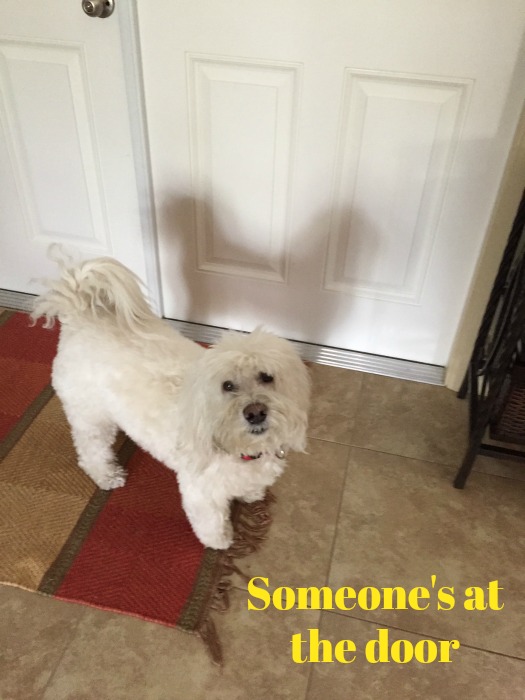Dog Barking
Solutions from the World's Best Dog Trainers
How do I get my Coton to stop barking?
This question has been asked dozens of times over the years. I’ve offered dog barking solutions in various ways:
- Free Ebook “10 Things Every Coton Parent Should
Know” with a section on barking
- Read the dog barking solutions by comments from our visitors
- Get general tips on how to stop barking here
Or…
I thought it would be valuable and fun to see what advice the world’s top dog trainers give to this common problem. I’ve only selected well known professionals who believe in humane, cruelty-free dog barking solutions.
Some of these trainers use similar training methods, and some have unique techniques
for dog barking training. But they all agree that positive, loving, consistent training is essential for a happy well
behaved dog. Many people just give up too soon.
These trainers also agree that it’s important to understand why your dog barks and if there’s any breed specific traits that come into play.
The Coton de Tulear is a sweet and gentle dog, but they are
also known to be territorial and will bark to protect and guard what’s
perceived to be their domain. This barking can become a nuisance if you and your dog aren't communicating properly.
Barking to let you know that someone's at the door is a good thing. UNLESS it becomes excessive and a nuisance. So for this dog trainer comparison, we're going to see how these top 5 trainers suggest dealing with extreme barking when someone is at the door.
Dog Barking Solutions from the Pros:
Background:
- Brandon’s mission is to save shelter dogs and has built his career on rescuing and rehabilitating rescue dogs.
- His parents were wild animal trainers.
- He’s trained over 1000 dogs and 300
animals for Hollywood productions including the dogs of many celebrities.
- He’s an Emmy award winning host of Lucky Dog TV show which highlights second chance stories of rescue dogs.
- Website: Canineminded.com
Philosophy:
- You must start with basic obedience to have a well-behaved dog (sit, stay, down, come, off, heel, and No!).
- Control is the first step in the training process. You must be the leader.
- Successful training requires a combination of mental and physical practices.
Control – Train - Treat
Brandon’s Dog barking solutions when someone’s at the door:
Brandon, like Victoria Stilwell, trains a dog to stop barking by first teaching them to bark on command.
1. Have small healthy treats available
2. Put your dog on a leash
3. Teach your dog to bark on command. How?
- Have someone knock on the door or ring the bell (if you’re alone, you can crack the door open enough so you can do this yourself).
- Stand between the door and your dog and give a hand signal as you say “Speak”.
- While your dog’s barking, give him a small treat.
- Repeat this several times throughout the day
- Keep it up until your dog “speaks” on command with or without the doorbell.
4. Once your dog can bark on command, give your dog the “speak” command as soon as he starts barking. Then give a “Quiet” command in a soft voice.
- As soon as he stops barking for a few seconds, give him a treat.
- Keep practicing and adding a few seconds of silence before you reward him. Your dog should be able to be quiet for 10 to 15 seconds with some practice.
5. Repeat this several times a day for about 10 minutes at a time.
6. Slowly wean your dog away from the treats.
Background:
- Zak started as a Pet Smart dog trainer and has trained thousands of dogs over the years.
- He performed at Stunt Dog Productions.
- He has the most popular YouTube channel with more subscribers than any other trainer – Zak George’s Dog Training Revolution (the videos are free if you don’t mind all the advertisements)
- Star of Animal Planet’s Super Fetch TV show and the BBC show Who Let the Dogs Out.
- Book: Dog Training Revolution
Philosophy:
- Zak believes that we need to connect with our dogs and make training fun.
- Like all the other top trainers, he only practices humane training techniques.
- He uses positive reinforcement to promote good behavior.
Zak’s Dog barking solutions when someone’s at the door:
Zak’s dog barking training is reward based. Like the other trainers, he believes that understanding why your dog barks is necessary before trying to change the behavior.
It's a good idea to set up training scenarios for short periods throughout the day. Start small and gradually increase the difficulty. This builds good communication with your dog.
1. First, provide appropriate exercise – especially if barking is due to too much energy, boredom, or frustration. The best time to correct unwanted barking is right before it occurs. Success comes with lots of practice.
2. Have someone knock on the door or ring the bell.
3. Shift your dog’s attention from whatever’s causing the barking to you instead. Have your dog look at you.
4. Use powerful rewards to capture your dog’s attention. For most dog’s, food or play are strong motivators.
5. When you get your dog’s attention, ask him to sit and then reward him with a small treat (turkey, carrot, etc.).
6. Give your full attention to these training sessions.
In a nutshell, you stop nuisance dog barking when you:
Get your dog’s attention fully on you, stop the barking before it occurs, reward heavily, and be patient and consistent.
Background:
- Dog trainer and behaviorist
- Works with SPCA and other rescue organizations
- Lives in New Zealand, trained by dog behaviorists in the U.S. and U.K.
- Spent years studying various dog training methods
- Created TheOnlineDogTrainer.com
Philosophy:
- The foundation of Doggy Dan's training is the importance of being the pack leader - without force, fear, or aggression. He has a system of 5 Golden Rules that teaches you how to take the lead, thereby freeing your dog to relax and give you complete control.
- Understanding the cause of excessive barking is essential to finding a solution. It's important to treat the root cause, not the symptoms of the behavior problem.
- He doesn’t usually use treats to stop barking. He teaches dogs to change their behavior of their own free will (with a little help from us). Doggy Dan feels that using food isn’t powerful enough motivation to solve serious dog barking. Using food is okay, but only if used in conjunction with other training methods.
Doggy Dan’s Dog barking solutions when someone’s at the door:
1. Use the calm freeze technique to relax your dog. Like Cesar Millan, Doggy Dan is a big proponent of using our human energy to communicate effectively with our dogs. Put 2-3 fingers underhanded through your dog’s collar underneath his chin. Don’t speak too much and just breathe calmly and deeply so your energy will calm your dog.
2. Stand between the door and your dog, so you are keeping him out of the path of the perceived danger on the other side of the door.
3. No cuddling or yelling – this only enforces the unwanted barking behavior.
4. If your dog continues to bark, put him in time out so he learns that barking equals being banned from you.
Background:
- Star of the TV Show, The Dog Whisperer.
- Started his career as a dog groomer.
- Cesar got his big break by word of mouth when Will Smith and Jada Pinkett spread the word about his talent with animals.
- He created a Dog Psychology Center in South Los Angeles, rescuing animals from shelters who are considered “unadoptable.”
- Book: Cesar's Way
Philosophy:
- Cesar doesn’t do obedience training; he leaves that for other trainers. His focus is on rehabilitation and dog psychology.
- He works with energy and touch instead of words and commands.
- The essence of his training method is “the power of the pack” leader and follower philosophy, where Cesar teaches people how to become the pack leader.
- He believes that spoiling our dogs puts them in the role of leader where they are more stressed, unhappy, and that’s when behavior problems occur.
- Cesar claims that if a person can’t manage their dog’s barking, they’ll also have trouble managing other areas of their lives.
Cesar’s Dog barking solutions when someone’s at the door:
Excessive dog barking is all about YOUR energy. Be calm, or your frustration will transfer to your dog. Use a look, sound, or physical correction to stop the barking.
Cesar says that we should provide affection only after exercise and discipline.
Practice training session:
1. Get your dog to sit
2. Ring the doorbell
3. If your dog doesn’t react, she gets a treat. If she barks, redirect her with a small treat without giving it to her yet. Get her to sit calmly and wait.
4. When she stops barking for a few seconds, give her the treat.
5. Repeat.
6. Gradually reduce the treats.
Your dog will learn that the doorbell equals a treat, but only if she’s calm and not barking.
Background:
- Victoria is a dog behavior consultant and educator.
- TV Show - It’s Me or the Dog
- Victoria Stilwell Positively Dog Training is her network of professional, positive reinforcement dog trainers around the world
- Website: Positively
Philosophy:
- Victoria is a proponent of positive reinforcement and force-free training using humane techniques.
- She believes alpha dog or pack leader training using punishment, intimidation or fear is unacceptable.
Victoria’s Dog barking solutions when someone’s at the door:
Set up training scenarios. Have someone ring the bell.
1. Check your dog’s body language to determine if she’s anxious, excited, or bored.
2. Have someone ring the bell or knock on the door.
3. When your dog barks, give a vocal command like “Speak”.
4. Then give your dog the “Quiet” command and show her a treat. When she stops barking for a few seconds, you can give her the treat.
5. Repeat several times a day until she’s quiet for longer periods of time.
6. Start weaning her away from the treats, but continue praising her good behavior.
Of course, there are hundreds of dog trainers available to help you learn dog barking solutions and to help with other unwanted behavior issues.
It's a good idea to find the training method that resonates with you and then stick with it consistently. But, you can also pick and choose the best ideas from all of these trainers and use the ones that work for you and your dog. After all, that’s what they did. These trainers researched dozens of training methods and then incorporated the best ones to make it their own. You can do the same thing.
Regardless of which training method you choose, you can’t go wrong if you follow these simple rules:
- Understand why your dog is barking
- Your dog picks up on your energy – so stay calm
- Only use positive training methods – no yelling or hitting EVER
- Be patient and consistent.
- Get help from professionals if you cannot solve the problem on your own.
Need help with other Coton behavior issues? Learn more here.
Home | About Me | Contact Me | Privacy Policy |Disclosure
Copyright© 2008- All Rights Reserved















